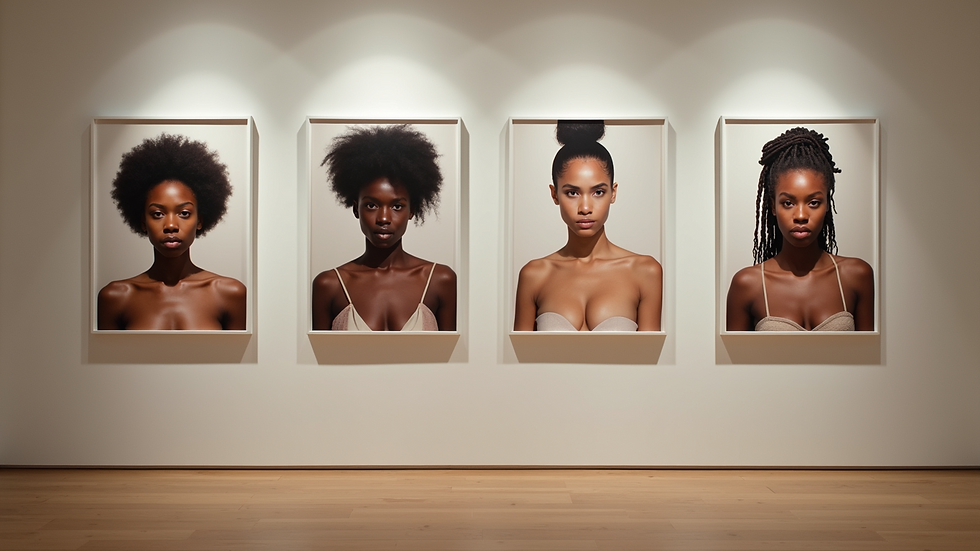Exploring the Human Body as Artistic Medium
- Lesley Stedmon
- 3 days ago
- 3 min read
The human body has long served as a canvas and a tool for artistic expression. Artists across cultures and centuries have used the body not only to create art but also to communicate ideas, emotions, and identities. This post explores how the human body functions as an artistic medium, highlighting its unique qualities and the ways artists harness its potential.
The Body as a Living Canvas
Using the body as a canvas means transforming skin into a surface for visual art. This practice dates back thousands of years, from tribal body painting to modern tattoo art. Unlike traditional canvases, the body is alive, textured, and constantly changing, which adds layers of meaning to the artwork.
Tattooing is one of the most widespread forms of body art. It combines permanence with personal storytelling. Each tattoo can represent memories, beliefs, or cultural heritage.
Body painting offers a temporary form of expression. Artists use paints to create intricate designs that interact with the body's shape and movement.
Henna art is another example, where natural dyes create detailed patterns that fade over time, symbolizing impermanence.
The living nature of the body means the artwork is dynamic. Movement, aging, and even emotions can alter how the art is perceived.
Performance Art and the Body
Beyond visual decoration, the body itself becomes the medium in performance art. Artists use their bodies to convey messages, challenge norms, or evoke emotional responses.
Marina Abramović is a pioneer in this field, using endurance and presence to engage audiences deeply.
Body movement and gestures can express complex narratives without words.
Interactive performances invite viewers to connect physically or emotionally with the artist’s body.
This form of art blurs the line between creator and creation, making the body both subject and object.

Sculpting and Modifying the Body
Some artists take a more physical approach by sculpting or modifying the body itself. This can involve temporary or permanent changes.
Body modification includes piercings, implants, and surgical alterations. These changes can be artistic statements or personal transformations.
Body casting captures the form of the body in materials like plaster or resin, preserving its shape as a three-dimensional artwork.
Makeup and prosthetics transform appearances, often used in theater and film but also in fine art contexts.
These methods highlight the body’s physicality and its capacity to carry meaning through form.
The Body in Photography and Visual Media
Photography and video have expanded how the body is used as an artistic medium. The camera captures moments that reveal the body’s beauty, vulnerability, or strength.
Portrait photography focuses on the face and expression, telling stories through subtle details.
Nude photography explores themes of identity, freedom, and natural form.
Body-focused video art can document movement, transformation, or interaction with environments.
Lighting, angles, and composition all influence how the body is represented and interpreted.
Cultural and Social Dimensions
Art involving the body often reflects cultural values and social issues. It can challenge stereotypes, celebrate diversity, or critique societal norms.
Gender expression through body art and performance questions traditional roles and expectations.
Rituals and ceremonies use body decoration to mark identity and community belonging.
Activist art employs the body to raise awareness about topics like body autonomy, disability, and race.
Understanding these contexts enriches appreciation of body-based art.
Practical Tips for Artists Using the Body
Artists interested in working with the body should consider several practical aspects:
Respect and consent are essential when involving others’ bodies.
Safety matters, especially with materials applied to skin or body modifications.
Skill development in anatomy, movement, or makeup can enhance the quality of work.
Documentation helps preserve temporary art forms like body painting or performance.
Experimenting with different techniques can lead to unique and powerful creations.
The Future of Body Art
Technology is opening new possibilities for body art. Digital projections, wearable electronics, and augmented reality can transform how the body is used as a medium.
Projection mapping can turn the body into a dynamic display surface.
Interactive wearables respond to movement or environment, blending art and technology.
Virtual reality allows artists to create immersive experiences centered on the body.
These innovations promise to expand the boundaries of artistic expression.
Exploring the human body as an artistic medium reveals its incredible versatility and depth. Whether through painting, performance, modification, or digital innovation, the body offers a unique way to connect art with life. Artists who embrace this medium can create works that resonate on personal, cultural, and emotional levels. If you are inspired, consider how your own body or the bodies around you might become part of your creative journey.




Comments